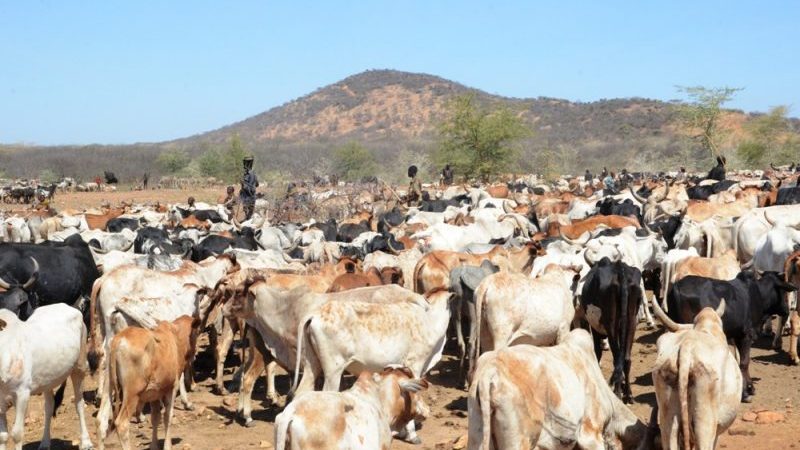On an unseasonably hot mid-September Friday afternoon, more than 100 pastoralists drive their cattle to Kobebe dam to drink, jostling for space.
The dam in Moroto district, northeastern Uganda, attracts herders with cows, goats, sheep, donkeys and camels from far and wide. Up to 5 million animals a day drink and graze nearby.
Simon Lomonyang trekked 50 kilometres here with his cattle from neighbouring Amudat district, and plans on staying for a week as he and his sons pondered their next move.
“I don’t think I will go back home soon,” the father of five says, in between barking orders to his sons as they herd their 40 head of cattle. “I came here for water, but there is not enough pasture so I have to go to another area but we don’t know where.”
With conditions getting worse, Lomonyang foresees his sons and grandsons traveling even longer distances in search of good grazing land.
This is part of Karamoja, a hotspot for climate change impacts bordering on Kenya and South Sudan. For decades, the sub-region has been stereotyped, marginalised, and ostracized, seen by the rest of the country as a no-go zone. Although that is changing, thanks in part to a steady flow of donor-funded recovery programmes, the journey to walk remains long.
Far from the urban centres, bustling with aid workers, out here the people face a double tragedy: extreme climate variations and chronic poverty.
During rainy seasons rivers flood, gardens are submerged and roads are cut off for days. When the sun shines shines, pastoral communities roam – sometimes across the border to Kenya – in search of water for their animals. Competition for grazing land has often sparked conflict between rival tribes.
Since the 1960s, average temperatures in the region have risen by 1.3C, while the number of extreme hot days increased 20-28%.
In the last twenty years, a plethora of development programmes have aimed to boost Karamoja’s prospects, variously focusing on health, education, infrastructure, livelihood restoration, food security and climate change.
But they are not always well received. “Most have been carelessly implemented,” complains Francis Kiyonga, a local councillor in Amudat district.
“We cannot talk about policies while structures for implementation of the projects are lacking,” Kiyonga says. “Most of the activities, including sensitisation of people about what needs to be done, are thriving in district towns/urban centres but you go down [in Amudat] and talk about climate change, the majority of the people are clueless, and yet they are the most at risk.”
During the recent 2017-18 drought, Kiyonga said the entire Karamoja sub-region lost 2,000 head of cattle “and if pastoralists had not moved to areas with water, more heads would have died”.

A boy herds cattle in Karimoja, Uganda (Pic: Daily Monitor)
The government promotes valley dams as a way of conserving water. They are a partial solution, but their long-term viability is doubtful.
Kobebe’s construction in 2011 certainly changed the dynamics of the area. Pastoralists who previously migrated downriver to Teso sub-region in times of drought, clashing with its regular inhabitants, can instead camp out by the reservoir. But there is another source of tension: the water source attracts herders from Turkana, across the border in Kenya. The Ugandan military is usually on standby.
While the dam offers a buffer against variable rainfall, its usefulness still depends on the weather. Already in the extreme droughts of 2014 and 2015, the 2.3 billion-litre capacity Kobebe reservoir dried up completely and the dam started cracking. As temperatures rise, water stored in this way will evaporate more quickly.
The Ugandan government has secured €20 million ($23m) from the German government, through the seven-member Intergovernmental Authority on Development (Igad), to build three large valley dams in Moroto, Kotido, and Kaabong.
Separately the €150m ($170m) multi-sectoral Development Initiative for Northern Uganda (Dinu), funded by the EU, German, British and Ugandan governments, will bring smaller “valley tanks” to each parish in Amudat and Moroto.
District officials questioned whether this was the most appropriate intervention, grumbling to CHN about a lack of consultation on the ground. Researchers from Nairobi and Makerere universities found in a 2014 study most valley dams had little community buy-in and as a result were poorly managed.
European Union officials in Kampala referred the matter to the Uganda authorities for comment. Ugandan officials insisted wide-ranging consultations were carried out in all areas set to benefit from the project. Those complaining are “selfish individuals,” they said, who want specifically tailored programmes for their areas that resources don’t permit.
Officials also indicated that consultations on the Igad-funded project are ongoing.
Climate change impacts are compounded by other environmental problems. Trees are being cut down for fuel faster than they regrow. Pastoralists periodically burn the bush as a method of pest control. Lately, there has been a surge in mining activity.
Chebet Maikut, head of climate change in the ministry of water and environment, said government and development partners were pursuing measures like tree-planting too. As temperatures continue to rise, though, it is a race against time.
“Karamoja and the entire cattle corridor (from south western Uganda to the north east) are already on the brink,” Maikut said. “Any increase in temperatures, as it is expected, however minor it gets, will just shatter livelihoods.”
This article was produced as part of an African reporting fellowship supported by Future Climate for Africa.
